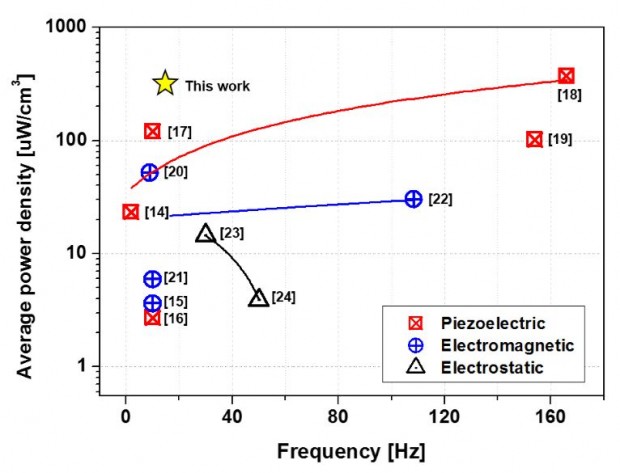본문
Impact-based Piezoelectric Vibration Energy Harvester
By Prof. Chang-Hyeon Ji (cji@ewha.ac.kr)
Department of Electronic and Electrical Engineering
Recently, research interest in micro power generation using energy harvester has been growing steadily for applications such as wireless sensor nodes, implantable devices, health monitoring systems and wearable devices. In these applications, autonomous power supply unit is preferable when the device is unsuited for a conventional wired supply of power or is completely separated from the outside world. Utilization of primary battery cell can be the most straightforward choice in specific devices at the cost of limitation in lifetime and need for a periodic replacement. Also, repeated charging can be an issue for devices with secondary batteries. Therefore, harvesting energy from renewable energy sources such as wind, heat, sound, light, and vibration could be an attractive solution for a low power consuming device with difficulties in battery replacement or charging. Among the various energy sources, environmental vibration has drawn considerable attention from the researchers due to the advantages such as high accessibility, ease of device volume reduction and fabrication, availability of straightforward energy conversion mechanisms, and abundance in nature.
This paper presents an indirect impact-based piezoelectric vibration energy harvester using freely movable metal sphere as a proof mass and an MFC (Macro Fiber Composite) beam as a piezoelectric cantilever (Fig. 1). Impact between the spherical proof mass and both ends of the channel generates MFC cantilever vibration in response to low frequency external vibrations such as human-body-induced motion. By utilizing the unique indirect impact mechanism, catastrophic failure of the piezoelectric material due to impact can be avoided and frequency dependence of the output power can be removed. A proof-of-concept device has been designed, fabricated and tested using vibration exciter (Fig. 2). Analytical model has been developed by examining the behavior of indirect impact system and MFC cantilever. Moreover, vibration mode of the MFC cantilever has been analyzed with finite element analysis and frequency domain analysis. With the developed model, theoretical open circuit voltage has been compared with experimental results (Fig. 3). Maximum peak-to-peak open circuit voltage of 42.2 V and average power of 633.7 μW have been obtained at 3g acceleration at 17 Hz. Long-term reliability of the device has been verified by cyclic testing. After the measurement of basic characteristics, we have proposed a new device with improved output performance which generated maximum average power of 963.9 μW at 3g acceleration at 18 Hz. To improve the long-term reliability, modified device with titanium alloy housing has been fabricated which provided 11.9% power decrease after 489,600 cycles of operation. Device proposed in this research showed superior output power characteristics compared to previously reported low frequency vibration energy harvesters (Fig. 4).

Figure 1. Schematic diagram of the designed device.
a |
b |
Figure 2. Fabrication results: (a) top side, (b) bottom side.

Figure 3. Comparison of the simulated and experimented open circuit voltage waveforms.

Figure 4. Performance comparison of the energy harvesting devices (average power density versus frequency)
* Related article
Suna Ju, Chang-Hyeong Ji, Impact-based piezoelectric vibration energy harvester, Applied Energy, 214: 139-151, (2018)














